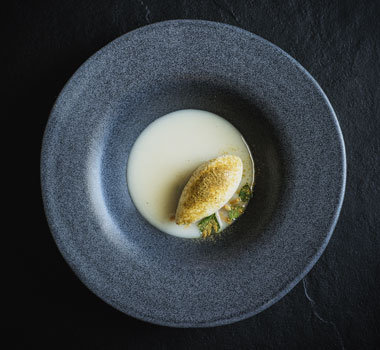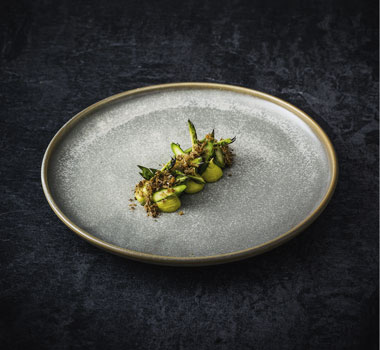
Food
Reinterpreting the Past
Feisty chef Monique Fiso is putting Māori cuisine on the world’s table.
Wellington, New Zealand’s capital city, stakes a claim to having more restaurants per head of population than New York. Competition between them is fierce, yet one restaurant, Hiakai (which means ‘hungry’ in Mãori), is booked out weeks in advance. In a renovated Edwardian building on top of a former lime kiln, Hiakai’s welcoming space includes a circle of booths under glowing lamps, and an open-plan kitchen where you can watch chefs plating up, and see Hiakai’s founder, chef Monique Fiso, rattling the coals in a woodfired parrilla stove.
By reclaiming her Maori and Pacific Islander food heritage, and reinterpreting indigenous New Zealand ingredients and techniques in a fine-dining style, this determined chef is making an impact beyond her restaurant; even New Zealand’s ‘signature French’ restaurants present bilingual Mãori menus on occasion.
Fiso knew from the age of seven she wanted to be a chef, after helping her Samoan grandmother prepare food for huge family gatherings. However, “A lot of the food that I ate was very different to what my pakeha [white] friends were eating, and I was kind of embarrassed about it,” she says. In the era Fiso was growing up, she found it better not to identify as being Mãori.
But things have changed. “Looking at New Zealand now, and how people are embracing te reo (Mãori language), and different parts of Mãori culture,” she notes, “there’s been a massive shift, which is great.”
By sheer coincidence, the night Hiakai opened was also the launch of The Final Table, a Netflix chef competition in which Fiso was one of the stars. The series has been criticised for focusing too much on the difficulties faced on set by Fiso and her female teammate, Indian chef Amninder Sandhu. But while some episodes may not have been kind to Fiso, the show has given her international attention. “It was good to be the flag bearer,” she says, “to show there are people down in New Zealand doing food that is interesting and worth coming to New Zealand for.”
Another upside: she has been inspired to collaborate with some of her most interesting fellow contestants, such as ‘travelling culinary artist’ Charles Michel and Sydney’s beloved Mark Best.


Pictured above (from left to right): The muted tones of Hiakai; Wood-fired tarakihi, manuka ash dusted avocado, sugar snap peas, zucchini, compressed cucumber and kawakawa dressing.
earning her stripes
Like her international peers, Fiso has serious chef credentials. She left school early, keen to get her cooking qualifications, and then hung around the kitchen at Martin Bosley’s, a famous restaurant in Wellington, asking to work until she was given a tryout, shortly followed by a job. At the age of 19 she left for New York to gain high level experience at several acclaimed restaurants. One of these was fellow New Zealander Matt Lambert’s The Musket Room, which was awarded a Michelin star after Fiso joined as sous chef.
After seven years away, Fiso returned. “I came home thinking ‘I just want to chill out and relax, and do nothing for a while”, she recalls. “But I got really bored after a week, and then all of a sudden I went: ‘actually no, I’ll just start a business’ – the complete opposite to chilling!” Hiakai started as a series of pop-up restaurants, featuring traditional underground hangi cooking.
The documentary, Hiakai > Monique Fiso by foodie filmmakers Stone Soup reveals the hard work that went into Hiakai’s creation. It shows Fiso digging hangi pits, weaving by hand the food-steaming baskets which go in them, and, out in the bush, foraging for ingredients.
At the same time, Fiso was on a steep learning curve, teaching herself about Mãori food, looking up old books and archives, and carrying out “a lot of trial and error and experimentation,” she describes.
She sought out mentors: two Mãori elders, Prof Nick Roskruge, an agronomist at Massey University, and traditional Mãori chef Joe McLeod, “a really amazing resource”, who still helps these days by going out foraging with Fiso and her team.
But in those days, a team was just a dream. “For the first two and a bit years of Hiakai, it was me, just me, and it was hard,” Fiso emphasises. “It was so hard, just to get to that point of generating enough interest to actually open it as a restaurant.” She wryly notes that “it was a very character-building couple of years.” But the success of the pop-up versions created the impetus that made Hiakai financially possible, and also helped to establish supply chains for ingredients.

Pictured above: Monique is dedicated to cooking with traditional Mãori methods.
local flavours
Hiakai uses native plant ingredients you may be familiar with, such as kumara, introduced to New Zealand in the 13th century by early Mãori settlers, and many which you may not, such as horopito, or pepper bush, whose leaves pack a peppery punch, kamokamo, a kind of squash, and taewa (Mãori potatoes). Taewa are fermented and combined with sourdough to make the bread which graces the table at Hiakai.
I was presented with a choice of spreads for the taewa bread the night I dined there, one a wakame (seaweed) butter, and the other of whipped Titi fat, which was creamy and satisfying.
Titi, or mutton bird, can only be harvested by a particular Mãori iwi (tribe) on the Titi Islands off Stewart Island, so this is a fairly uncommon Mãori offering. Supply is not guaranteed: the annual harvest may not occur if members of the iwi decide they do not want, or are unable, to hunt that summer.
Naturally, local seafoods appear on Hiakai’s ever-changing degustation menus, sometimes in surprising guises, such as a green-lipped mussel-flavoured ice cream, served with a vichyssoise and crunchy potato bits, an amusing twist on the classic Belgian dish, moules frites.
Another key Mãori plant ingredient is mamaku, or black tree fern, a symbol of New Zealand. Fiso discovered that by cooking this down in its natural juices and its abundant collagen, she was could create one of her restaurant’s signature petit fours, a mamaku jelly.
Some of the Mãori ingredients come from licensed professional foragers. Fiso’s trailblazing has created interest in the more unusual ones, opening up new markets for them: “People are asking for those ingredients because they’ve seen them on Instagram,” she says.
Foraging is also a key task for her staff. Hiakai is open for service four nights a week; staff tasks include collecting ingredients, and experimenting to create new dishes. Fiso’s respect for her team (she employed them for six months of training before the restaurant opened) is equalled by their respect for her. “I’m really lucky,” she states, saying the previous day she had “a moment of feeling like a proud mum,” when, after she had cancelled a foraging session due to initial bad weather, her staff went out on their own initiative to surprise her.
It’s easy to conclude that Fiso’s passion for traditional cuisine, her hard work and her integrity, are the key ingredients which make up her ‘luck’.


Pictured above (from left to right): Green-lipped mussel ice-cream; Pipis and asparagus.